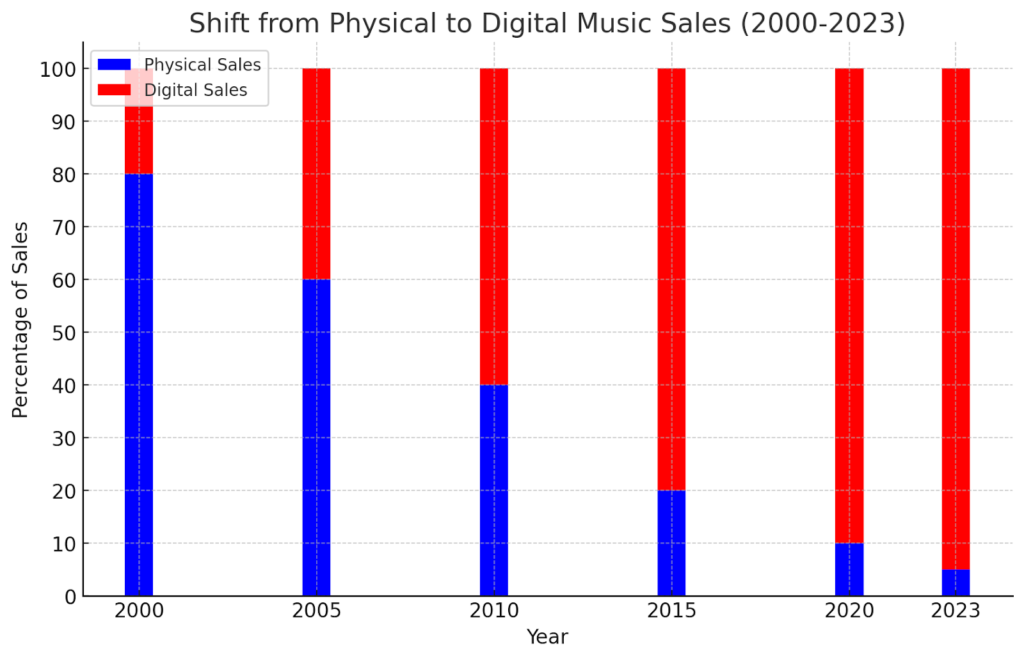The evolution of music distribution is a tale of technological innovation and cultural shifts. It’s a story that begins with the grooves of vinyl records and travels through the digital revolution, transforming not just how we access music, but how it reaches our ears. This journey from physical media like vinyl and CDs to the virtual realms of MP3s and streaming services marks a significant shift in the music industry. It has impacted everything from the way artists create and share their music to how fans discover and enjoy new tunes. In this exploration, we aim to provide a comprehensive overview of this transformation, highlighting its impact on the music industry, artists, and listeners alike.
The Era of Physical Media
The story of music distribution begins with the rise of vinyl records and CDs. These physical formats were not just mediums for music; they were cultural icons. Vinyl records, with their warm sound and large cover art, were treasured by music aficionados. CDs later took the baton, offering clearer sound and more portability. These formats dominated the music landscape for decades, with physical sales being the primary metric of an artist’s success and reach. They held a sense of tangibility and connection, a physical embodiment of music that digital formats have struggled to replicate.
The Digital Revolution
The advent of MP3s marked the beginning of a new era in music distribution. This digital format allowed music to be compressed and shared easily, paving the way for a revolution in how music was consumed. The rise of online streaming services like Spotify and Apple Music was the next major milestone, profoundly changing the music industry’s landscape. This digital transformation enabled instant access to vast music libraries, altering not just consumer behavior but also the ways in which artists release and promote their music. The convenience and accessibility of digital formats have reshaped the industry, challenging the traditional paradigms of music distribution and consumption.
Guide for Navigating Modern Music Distribution
In the ever-evolving world of music, understanding and mastering digital distribution channels is crucial for artists.
- Embracing Online Platforms: Artists should familiarize themselves with various online platforms like Spotify, Apple Music, and Bandcamp. Each platform has its unique features and audience, and being present on multiple platforms can maximize reach.
- Effective Digital Marketing: Develop a solid digital marketing strategy. Utilize social media to promote releases, engage with fans, and build a community. Employ targeted ads, email marketing, and content marketing to broaden your reach.
- Audience Engagement: Engage with your audience regularly. Use social media, live streams, and interactive content to keep them interested. Respond to comments, host Q&A sessions, and share behind-the-scenes content to foster a deeper connection.
The Transition from Physical to Digital in Numbers

In the stacked bar chart, vividly illustrates the dramatic shift from physical to digital music sales over the past two decades. Starting from the year 2000, when physical formats like vinyl and CDs dominated the market, we see a steady decline in their sales. Conversely, digital sales, encompassing MP3s, digital downloads, and streaming services, have surged significantly.
This chart not only represents the change in consumer behavior but also underscores the evolving revenue models in the music industry. By 2023, digital sales almost completely overshadow physical sales, marking a seismic shift in how music is consumed globally. The decline in physical sales from 80% to a mere 5%, paralleled by the rise in digital sales from 20% to 95%, highlights the radical transformation in music distribution and consumption.
Key Milestones in Music Distribution
- The Birth of Vinyl Records: The starting point of modern music distribution, vinyl records were pivotal in setting the stage for high-quality sound and durable media.
- The Rise of Compact Discs (CDs): CDs introduced digital sound quality and increased storage capacity, becoming the mainstream format for several decades.
- MP3s and Digital Downloads: The advent of MP3s marked a revolutionary shift, simplifying music storage, sharing, and online sales.
- The Emergence of Streaming Services: Platforms like Spotify and Apple Music radically transformed the industry, offering limitless music access through subscription models.
- The Advent of Smart Devices and Mobile Listening: The proliferation of smartphones and tablets further accelerated the digital music revolution, enabling music accessibility anytime and anywhere.
The Impact of Digital on Music Creation
The digital era has significantly influenced music creation and artist independence. Digital distribution platforms have empowered artists by offering tools and channels for independent music release, thus fostering creative freedom. This shift from traditional label dominance has allowed artists to experiment with their sound, cater to niche markets, and directly connect with audiences globally. The democratization of music production, enabled by affordable digital tools, has facilitated a diverse range of voices in the industry, enriching it with innovative sounds and styles.
Key Milestones in Music Distribution
- The Birth of Vinyl Records: Vinyl records marked the beginning of modern music distribution, offering high-quality sound and durable media.
- The Rise of Compact Discs (CDs): CDs brought digital sound quality and increased storage capacity, dominating the market for decades.
- MP3s and Digital Downloads: The introduction of MP3s revolutionized music distribution, making it easier to store, share, and sell music online.
- The Emergence of Streaming Services: Services like Spotify and Apple Music transformed the industry, offering unlimited access to music through subscription models.
- The Advent of Smart Devices and Mobile Listening: The widespread use of smartphones and tablets has further propelled the digital music revolution, making music accessible anytime, anywhere.
The Impact of Digital on Music Creation
The digital era has ushered in a transformative impact on music creation and artist independence. Digital distribution platforms have empowered artists by providing them the tools and channels to release their music independently, fostering a newfound creative freedom. This liberation from traditional label constraints has allowed artists to experiment with their sound, explore niche markets, and connect directly with audiences worldwide. The democratization of music production, through affordable and accessible digital tools, has enabled a diverse range of voices to be heard, enriching the music industry with innovative sounds and styles.
Some FAQs Answered on Music Distribution Evolution
How has digital distribution changed the way artists release music?
Digital distribution has made music release faster and more accessible, allowing artists to bypass traditional gatekeepers and reach global audiences directly.
What are the benefits of streaming services for artists?
Streaming services provide artists with a platform for widespread exposure, continuous revenue through royalties, and valuable listener data to inform marketing and touring strategies.
Has digital distribution affected the quality of music?
While it has led to a higher volume of music being released, it has also allowed for more diversity and experimentation in music creation.
In conclusion, the evolution from vinyl to digital distribution has been a journey of remarkable transformation in the music industry. This shift has not only changed how music is accessed and enjoyed but has also empowered artists with greater control and creative freedom. As we continue to witness the evolution of digital trends, their ongoing impact on the music industry remains a testament to the dynamic and ever-changing nature of music itself.

Eric Dalius is The Executive Chairman of MuzicSwipe, a music and content discovery platform designed to maximize artist discovery and optimize fan relationships. Outside of MuzicSwipe, he hosts the weekly podcast “FULLSPEED,” which highlights conversations with accomplished entrepreneurs. Eric is also committed to supporting education through the “Eric Dalius Foundation,” offering four scholarships to US students. Keep up with Eric on Twitter,YouTube, Facebook, LinkedIn, Instagram, and Entrepreneur.com.

